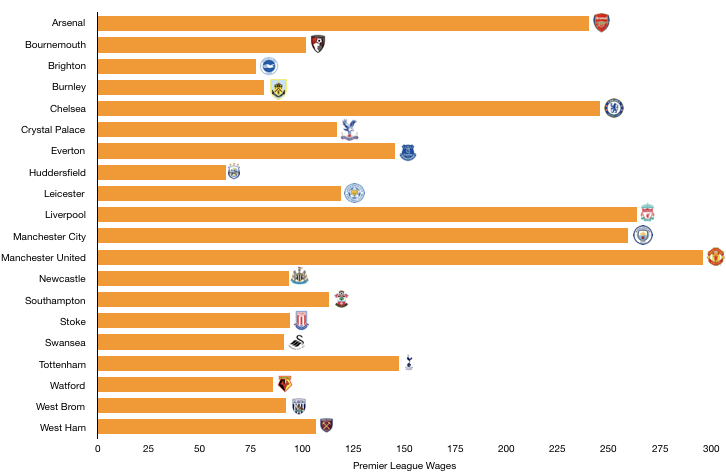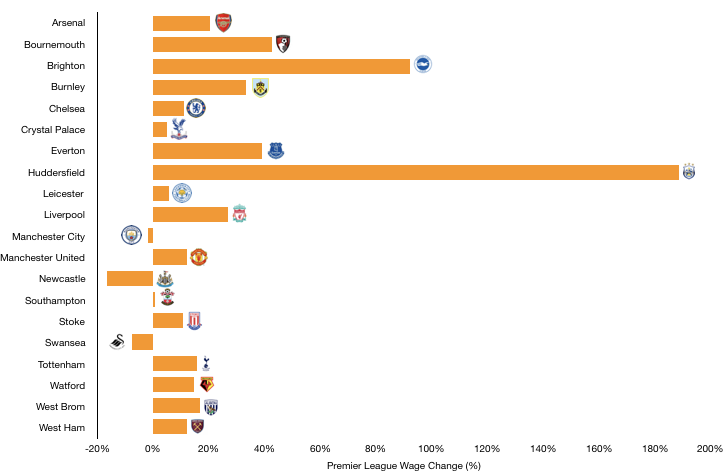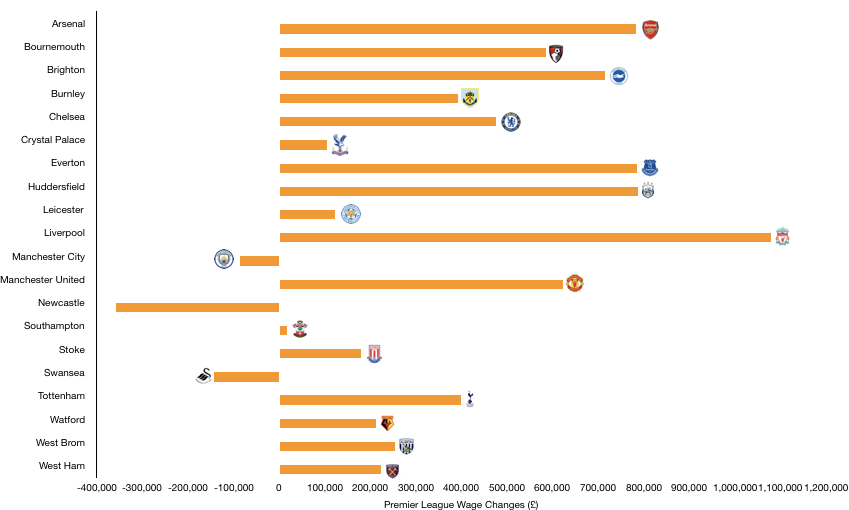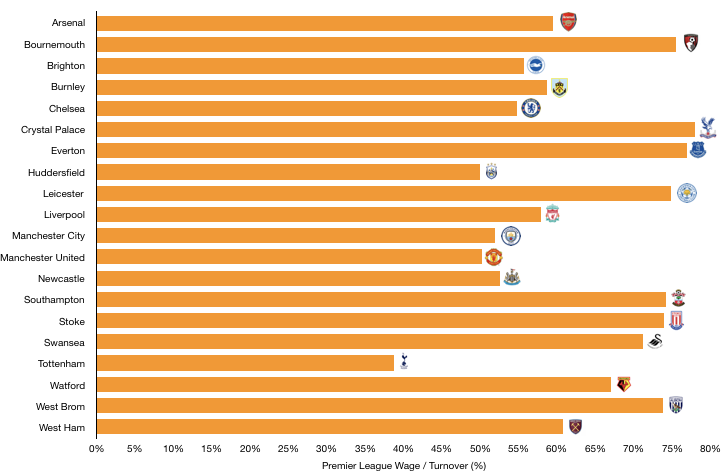2018 was another thrilling season with Manchester City brushing away all competition to take the crown with ease. At the bottom of the table mainstays Swansea, Stoke and West Brom met their doom with relegation.
However, this article is about finances, and more specifically wages and which clubs are spending the big bucks.
The 2017/18 season saw record levels of wages as the year on year growth in player salaries continued due to the riches of the Premier League reach new heights.
Wages increased from an eye-watering £2.5bn to an even more outstanding £2.8bn, a 15% increase and the equivalent of an extra £7.2m a week in wages!
This is largely driven by the mounting riches of remaining a Premier League club among the lesser teams and the need to compete in Europe and for trophies among the top 6.
The average wage bill of a Premier League club is £142m (or £2.7m a week). The average of the top 6 on its own is a jaw-dropping £242m (£4.7m a week), showing the vast difference financially between those at the top and the rest.
And despite the TV deal money stagnating in the most recent deal cycle, wage growth shows no sign of slowing down as clubs clamber to grab a share of the rising commercial revenue up for grabs.

The Big Spenders
The big wage spenders in 2018 were all up north, with Manchester United (£296m), Liverpool (£264m) and Manchester City (£260m) all spending in excess of £250m on wages (more than £4.8m a week).
Liverpool were the surprised package here as they began to make a concerted push to move back on their perch with big new signings such as Van Dijk and lucrative new deals for the likes of Salah, Mane, Firmino and co. that have so far been successfully.
Manchester City surprisingly saw a slight dip in their wage spend as incoming signings’ wages were recouped by selling and releasing deadwood.
Manchester United continued flexing their financial muscle, outgunning their neighbours to sign Sanchez on a mega deal which they are no doubt regretting. This added to an already bloated wage structure that continues to cause them trouble in discussions of new deals with the likes of Rashford and De Gea, who refuse to accept less than some of their underperforming team mates.
Tight Purse Strings
The paupers of the Premier League this year happened to be Huddersfield (£63m), Brighton (£78m) and Burnley (£82m) who all spent less than a third of what the big spending Scousers and Mancunians spent.
Outstandingly, all three of these clubs survived on their modest budgets, showing it’s not all about money, particularly Burnley who finished 7th, 11 places higher than their position in the wages table.
The low wages did however catch up to these clubs in 2019, with all three struggling near the foot of the table and Huddersfield were unable to stay afloat and fell to relegation, showing that maybe low wages are not sustainable over the long term.
Best of the Rest
Everyone else is somewhere in between this gulf and we are going to have a look at a few of the more notable wage bills.
Tottenham continue to mix with the heavyweights on a featherweight’s diet, managing to maintain a wage budget of £148m more than £100m less than Manchester United, Liverpool and Manchester City and nearly £100m less than their London rivals Arsenal (£240m) and Chelsea (£246m).
It’s worth also noting the increased ambition shown on the blue side of Merseyside with Everton’s wages approaching the same level as Tottenham at £146m, hoping to replicate the success Tottenham have had, although that is yet to materialise.
Bournemouth and West Ham both broke the £100m wage barrier for the first time, spending £102m and £107m respectively as they both looked to move up the table and consolidate their Premier League status.
The three relegated clubs were near the bottom of the wage tree, with Swansea (£91m), West Brom (£92m) and Stoke (£94m) all spending less than a £100m on wages, a figure that will fall dramatically reduce following their relegations.
Wage Growth

All bar two clubs (Manchester City and Newcastle) saw a growth in their wages.
Huddersfield were the big movers with wages nearly tripling from £22m to £63m (188%) on the back of promotion. Given the unexpected nature of their promotion due to their modest Championship budget, this increase was necessary and still left them firmly at the bottom of the wage bills in the Premier League despite an extra £786k per week in wages.
Another promoted club in Brighton also saw a huge rise in wages, almost doubling from £40m to £78m (92%) in order to compete in the ultra-competitive Premier League, an extra £715k a week.
Newcastle on the other hand already had a bloated wage bill following their relegation to the Championship and continued to trim the wages despite promotion as Mike Ashley looked to make it an attractive target as wages dropped from £112m to £94m (16%).

Bournemouth continued to grow as a club, spending an extra £585k a week, increasing their wages from £72m to £102m (42%). The same was the case for Burnley, who increased their wages from £61m to £82m (34%) as they consolidated their Premier League status.
Everton’s ambitions were shown by spending an extra £785k a week on wages, increasing their wages from £105m to £146m (39%), although the benefits are yet to be forthcoming under Marco Silva.
Liverpool were the big movers among the top 6 spending an unprecedented extra £1.1m a week in wages, while Arsenal (£783k a week), Chelsea (£479k a week) and United (£623k a week) were all free spending in 2018.
Financial Stability

The wage to revenue ratio measures financial sustainability and prudence. If the ratio exceeds 100%, a club is spending more on wages than the revenue they bring in, which means the club is loss making before taking into all other costs they face, a situation that will lead to financial ruin in the long run.
The higher the ratio, the less profitable a club can be and the less sustainable they are. A club’s wage/turnover ratio should be around 60%, with one higher than 90% largely unsustainable and one lower than 40% a poor use of resources and essentially ‘too safe’.
The average in the Premier League was 63% in 2018, ranging from 39% to 78%.
Tottenham were the lowest at 39%, with the prudent Daniel Levy taking tight to new levels, although the low ratio is partly due to a huge upturn in revenue that diluted the ratio significantly. New deals for Alli and Kane among others will see this ratio rise closer to 50% (although 2019 revenue is expected to rise), while they also have to manage finances due to their new stadium.
The top 6 continue to run financially smoothly despite their huge wage bills with Manchester United (50%), Manchester City (52%), Chelsea (55%), Liverpool (58%) and Arsenal (60%) all having ratios of less than 60% due to their high revenue which justifies their star players’ salaries.
The Promoted clubs were also in a healthy range with Huddersfield (50%), Newcatle (53%) and Brighton (56%) all in the 50s as the huge boost in revenue exceeded their rising wages (or falling wages in Newcastle’s unusual case).
Outside of this and among the mid table gang, the majority of ratios exceed 70%, a poor place to be in. Crystal Palace (78%), Everton (77%), Bournemouth (76%), Leicester (75%), Southampton (74%), West Brom (74%) and Swansea (71%) are all approaching the financial risk area.
Burnley’s ratio can be explained by bonuses following a great season but not much can be said for those outside this.
West Brom, Stoke and Swansea will need to drop wages fast to avoid financially issues following relegation with large losses on the cards if not.
Bournemouth and Southampton must be careful to not over exert themselves financially in a bid to survive and grow and make smart investments or risk financially ruin.
Everton need to trust that they are making the right moves and that revenue catches up with their rising wages soon to avoid the need to sell key players or revert to a much smaller budget and level of ambition.
I hope you enjoyed this article – Please share with a friend!

